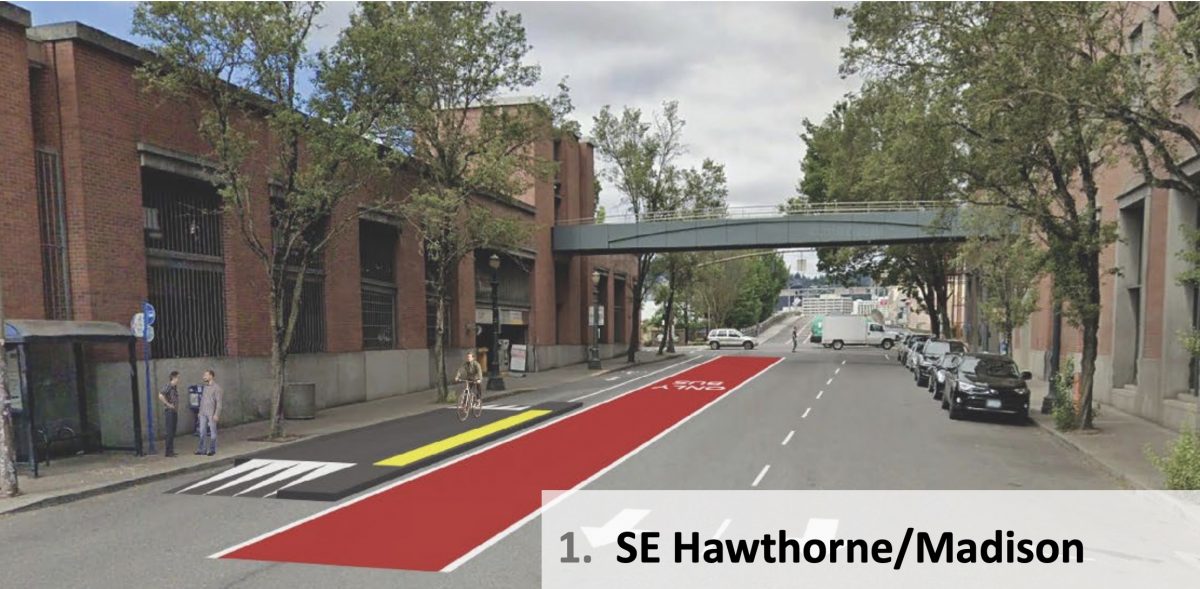
Two of Portland’s most vital bikeways are on the cusp of big changes.
The Portland Bureau of Transportation has projects in the queue that will reconfigure lanes on Northwest Broadway and Southeast Hawthorne. These are just two of the five projects PBOT plans to build in 2020 and 2021 as part of their Central City in Motion plan that began last year. Broadway will get bikeway additions and upgrades while Hawthorne (and its couplet Madison) will get a dedicated bus lane and bikeway updates between SE 12th and Grand. PBOT is also planning to repave Hawthorne from 24th to 50th. By linking with a sewer pipe repair project, PBOT is studying the potential of a new, safer cross-section for Hawthorne from 12th to 50th.
The implications of these changes could be huge. Here’s what you need to know…
NW Broadway
On Broadway, PBOT plans to add a northbound bike lane between West Burnside and Hoyt and more space for cycling in the southbound direction between SW Oak and Hoyt. In a presentation to the PBOT Bicycle Advisory Committee (BAC) January 14th, PBOT Project Manager Timur Ender laid out the details of the currently proposed design.
Ender said the $200,000 project includes: “paint and post” bike lanes in both directions, a roundabout south of Burnside, a right turn ban from Broadway to westbound Hoyt (sight of many right hooks), a beefed up crossing at SW Pine (near Mary’s Club), and rebuilt signals at Flanders and Glisan (to come in 2021 and 2022 as part of separate projects). To give the street a more “bicycle-centered approach” Ender said they’ll move the TriMet Line 17 bus off Broadway and onto the Transit Mall (SW 5th and 6th).
To get space for cycling, PBOT will prohibit on-street parking on the east (northbound) side of Broadway. Southbound, parking will only be allowed during off-peak hours and it will float in the street to protect the curbside bike lane.
“We’re trying to do something now. And we’re trying to do it with the resources we have.”
— Timur Ender, PBOT
Advocates have pushed for years for better bicycling on Broadway. Our first-ever parking-protected bike lane on Broadway near Portland State University was installed as a pilot project in 2009 — and has yet to be expanded. Despite being one of the busiest bikeways in the city and a gateway into downtown, most of Broadway’s bikeway is rife with substandard conditions — a door-zone bike lane and numerous right-hook hazards — and hasn’t changed much since the 1990s. BAC members hoping for a design that matches Broadway’s potential were unimpressed at PBOT’s plans. Ender acknowledged that the relatively small budget meant the project had to end at Oak (to connect with an existing bikeway, but leaving a 12-block gap to SW Clay) and that it allowed for only “paint and posts”, a reference to a lack of concrete features and use of those ubiquitous white posts that have become PBOT’s default “protection” for bike lanes.
Advertisement
(Photos © J. Maus/BikePortland)
Ender promised that once PBOT gets funding to upgrade the bikeway from Oak to Clay, they’ll go back to “harden” the design of this section. “We just want to repaint the street now while we work on a more permanent, longer-term solution,” he said. PBOT is in a holding pattern while they wait for the Metro Transportation Funding Measure vote. If that passes, it would fund the entire Central City in Motion plan to the tune of $80 million.
“This is egregious. This is our signature route and we should not have bikes sharing a roundabout with buses.”
— Iain MacKenzie, Bicycle Advisory Committee member
BAC member David Stein doubted the effectiveness of paint and plastic posts on a busy street like Broadway. Member Catie Gould asked whether PBOT could install a curb to add physical protection to the bike lane. PBOT Bicycle Coordinator Roger Geller said no because curbs would quadruple the cost of the project.
Member Iain MacKenzie was animated in his disapproval. He feels if PBOT is doing it on-the-cheap, the project scope should be larger. “If we’re not doing it well, why aren’t we doing the entire length of Broadway? We should at least build a network and at the least have Broadway be something that’s not a door-zone bike lane.” As for a proposed painted roundabout south of Burnside (where the bikeway will be shared with the bus lane), MacKenzie said, “This is egregious. This is our signature route and we should not have bikes sharing a roundabout with buses… If there’s not room to do a roundabout that includes protected bike lanes then there isn’t room to do a roundabout,” he added.
Ender explained that another challenge is that if the project costs are over $200,000, PBOT cannot deliver it in-house. “We’re trying to do something now,” he said, “And we’re trying to do it with the resources we have.”
Ender defended the project, saying, “From our point of view this makes a lot of connections and I expect it to increase ridership.” He also made it clear he could either do this “quick-build” now or do nothing and work on a larger project to be delivered in the future. “Should we not do this and the project on the shelf?” he asked BAC members, “We could, in theory, do that.”
The answer from the BAC was essentially, “No. We need stuff on the ground now. We just want a promise that this will get improved in the near future.”
This project is expected to begin construction in fall of this year. See the conceptual design and learn more at the project website.
Advertisement
SE Hawthorne/Madison
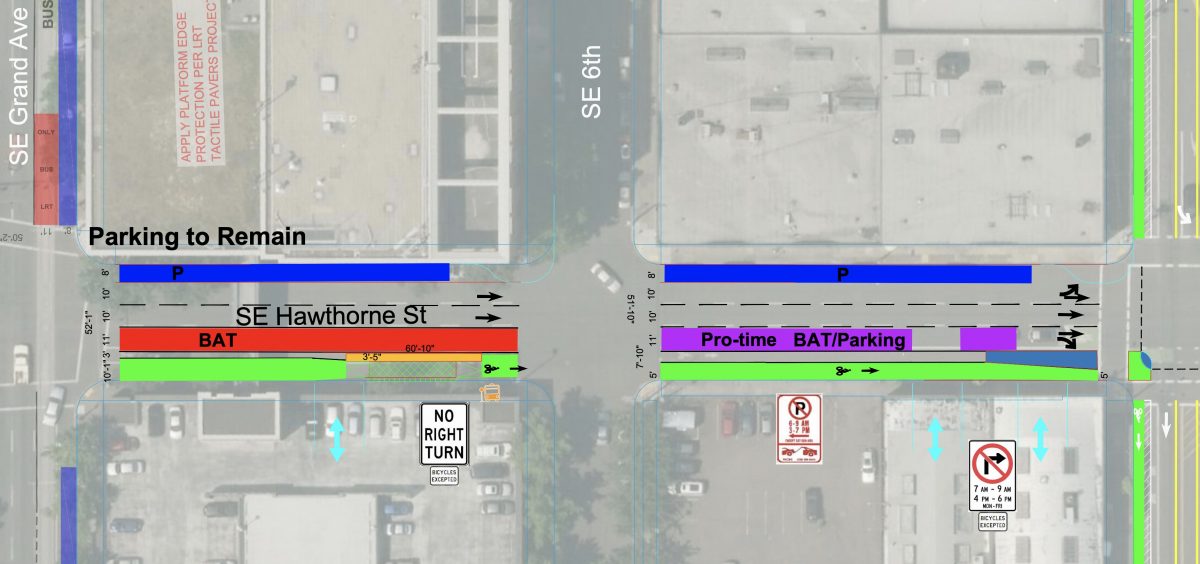
Also set to begin construction this fall are a host of updates to the all-important SE Hawthorne/Madison couplet.
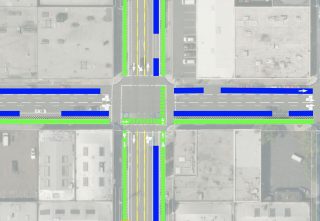
SE Hawthorne eastbound from the viaduct to SE 12th will get a new cross-section that includes a curbside bike lane with a buffer zone adjacent to a bus-only lane. The road currently has three lanes where people can drive. PBOT will reduce that to two lanes to make room for an 11-foot wide bus-only lane that will morph into a parking lane during off-peak hours (between 6:00 pm and 6:00 am). The bike lane will be eight feet wide with a 2 foot buffer zone, but it will pinch down to five feet wide at the intersections. At the TriMet bus stop at SE 6th Avenue, PBOT’s current design calls for the bike lane to go up-and-over the bus loading zone (see graphic).
BAC members were very concerned about the reduced width of the bike lane at intersections — especially because PBOT has decided to retain all the on-street auto parking on the north side of the street. Member Clint Culpepper said, “With biking speeds of 18-19 mph going downhill, the bike lanes should be as wide as possible with limited pinch-points. I’m very concerned about right hooks.”
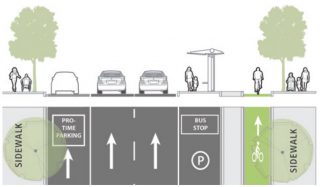
What’s interesting about this design is how PBOT Commissioner Chloe Eudaly’s Rose Lane Project has been added to it. When the Central City in Motion projects were adopted by council in November 2018, the bus-focused Rose Lane Project wasn’t on anyone’s radar. The design for Hawthorne passed by council (right) included a parking-protected bike lane that didn’t narrow at intersections and that went behind a floating bus island at 6th. The new design includes the bus lane at the expense of bikeway quality, because PBOT says they don’t have authority from council to remove the parking lane on the north side of the street. (*UPDATE: PBOT has changed the design based on BAC member feedback. Scroll down for more information.)
BAC member MacKenzie wasn’t happy about that. “The reason this [bikeway] is being pinched is because of the choice to add in an extra lane of traffic beyond what council approved. As for the bus,” he continued, “I wholly support that, but that is a change to what council approved and I don’t think it should be coming at the expense of the bikeway. It should come at the expense of the parking on the other side of the street.” PBOT’s Ender said they will consider removing some parking west of 6th to create more room for the bikeway.
On Madison, the bus lane will start on 10th. Ender said the bike lane will be curbside starting at 12th and then there will be a bus/bike weave between 7th and 6th with a bike box at 6th. The bus will then have a curbside lane all the way to SE Grand. Learn more at the project website.

In addition to these changes, PBOT is in the early outreach stages of a repaint and repave of Hawthorne between 24th and 50th. With a priority on safety, the current plan is to change the current profile of four lanes for drivers and two parking lanes to three lanes for driving — one in each direction and a center turn lane (Correction: This is just one possible scenario and not the “current plan”. Sorry for the error). With increasing demands for bus lanes and bikeways, there will be pressure on PBOT to do even more. Given Hawthorne’s importance in our road network, this is a golden opportunity to do something big and bold.
UPDATE, 2:25: “We are looking to improve safety and better serve businesses on Hawthorne,” PBOT’s Hannah Schafer said today. “We know how important Hawthorne is in our road network and we think this is an opportunity to do something big and bold.”
PBOT has scheduled six outreach events to discuss Hawthorne starting February 10th.
Open Houses
PBOT will share the latest designs, take feedback, and answer your questions on all five of their 2020-2021 Central City in Motion projects at two upcoming open houses:
Tuesday, February 18
4:00 to 6:00 pm
White Stag Building (70 NW Couch St)
Wednesday, February 26
5:00 to 7:00 pm
Revolution Hall – Astoria Room (1300 SE Stark St.)
UPDATE, 1/30 at 2:16 pm: In the two weeks since the BAC meeting, PBOT has responded to member concerns about SE Hawthorne and has changed the design. Below is an email from PBOT Bicycle Coordinator Roger Geller explaining the changes and rationale:
“It was clear to us that adding a bus lane that comes at the expense of the bicycling environment is contrary to city policy. More specifically, the reason the CCIM plan showed [permanent] parking on the south side of the street was to: (a) protect the bike lane, (b) provide pedestrian refuges and reduce crossing distance, and (c) allow bikes to use this space to pivot for two-stage left. With the introduction of a bus lane, the east bound bike lane gets pinched at the intersections and prevents the ability for future protected intersections and two-stage lefts & pedestrian refuges.
As a result, PBOT is proposing to adjust the cross section to an 8-9’ bike lane, a permanent south-side parking lane, a full-time 24 hr bus and turn lane, 1 full-time general purpose lane, and a pro-time parking lane on the north curb (which would be a travel lane between 2-7 PM).”
— Jonathan Maus: (503) 706-8804, @jonathan_maus on Twitter and jonathan@bikeportland.org
— Get our headlines delivered to your inbox.
— Support this independent community media outlet with a one-time contribution or monthly subscription.


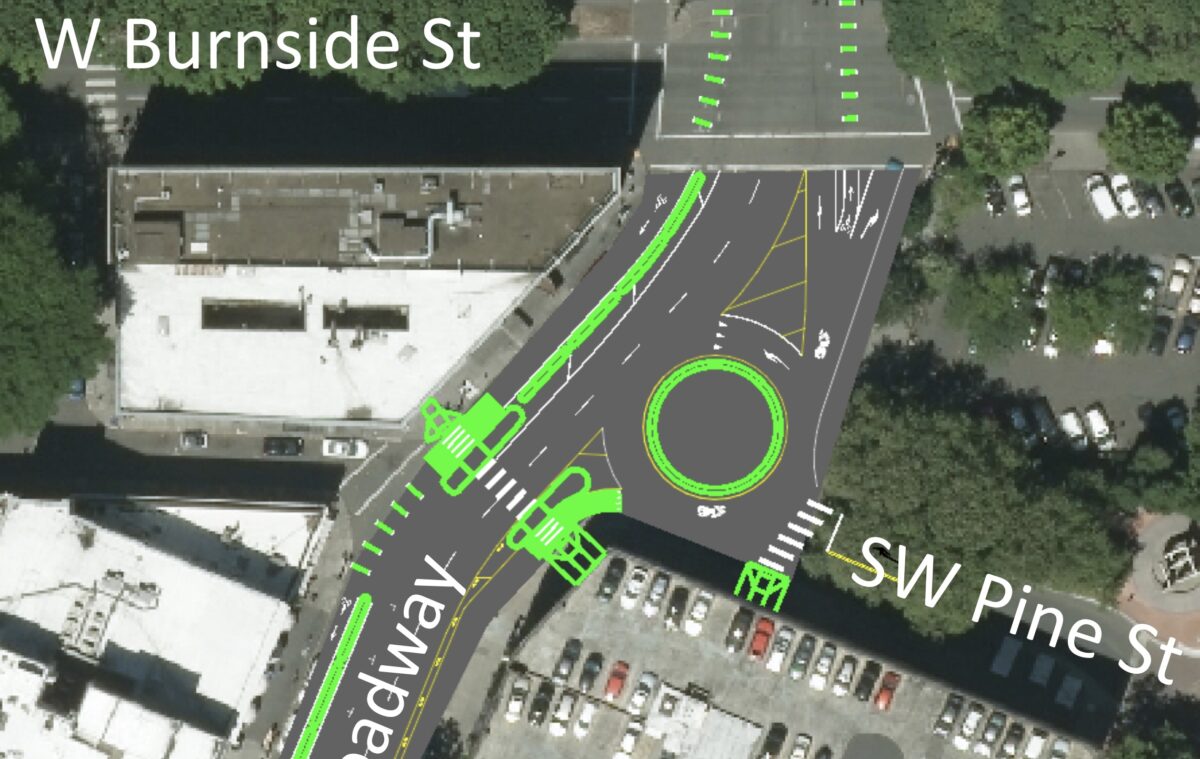

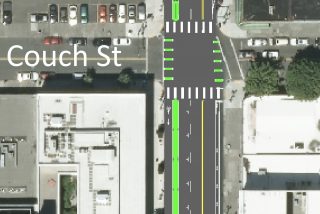

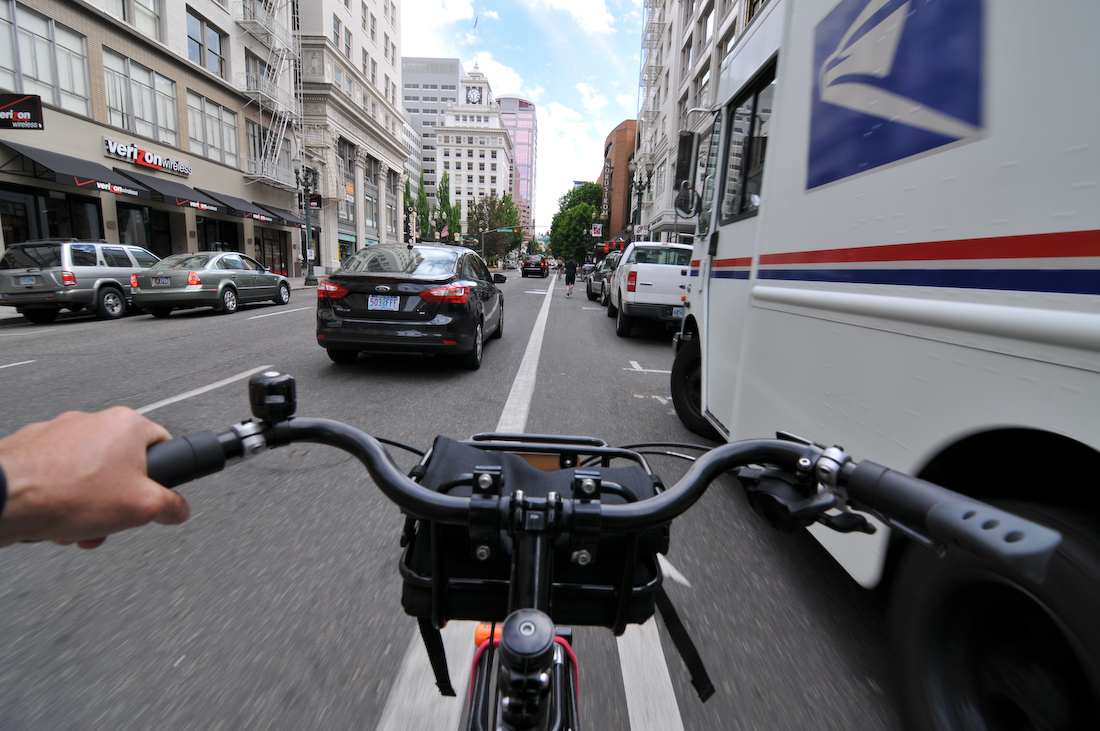

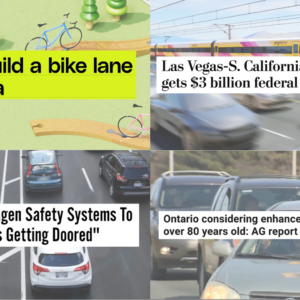
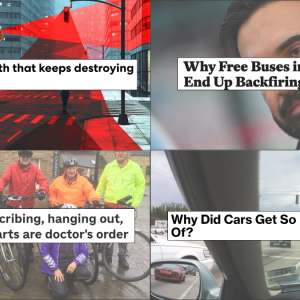
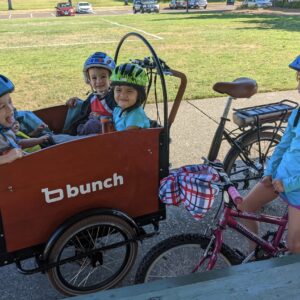
Thanks for reading.
BikePortland has served this community with independent community journalism since 2005. We rely on subscriptions from readers like you to survive. Your financial support is vital in keeping this valuable resource alive and well.
Please subscribe today to strengthen and expand our work.
Disappointing. These changes will not entice any of the ‘Curious but Concerned’.
Geeez, what a negative little hot take you have there. Reminds me of that part Dave Eggers book “Heroes of the Frontier” where the lead lady envisions a whole modern musical based around how callously we toss around the term “disappointed” these days (eg. the brunch spot was nice, but I was disappointed with their house cured salmon…).
Also, I think I straight up disagree with you. I’m totally picturing the novice biker that makes a comfortable loop of the waterfront. Then gets just a bit bolder and stays on the Hawthorne viaduct rather than reconnect to waterfront. And then gets all sort of intimidated that moment they start heading downhill towards 7th alongside real traffic with merging cars and buses and right hook potential. All they wanted was to make it to Ladd’s Addition to smell some roses!! This spot is so unbelievable essential in being that first real moment of riding in “city” traffic for folks. Not to mention, is there a spot in Portland that gets more bike traffic than each end of the Hawthorne Bridge? Not by much.
I’d say I’m pleased and satisfied, just about the opposite of disappointed.
I can understand the way both of you are feeling. We do need to keep some perspective when government doesn’t go as far as we want, yet is making steps forward. However, SilkySlim, keep in mind that these projects are happening in a context. The context (at least the way I see it), is that our city is fixated on incrementalism when it comes to transportation. And with each passing year, that approach puts biking further and further behind. The stats don’t lie. Fewer people are biking in Portland. One of the big reasons is that our bikeways are simply not good enough to attract new riders and anyone beyond the usual suspects. So… Given the years of preparation, anticipation, and rhetoric around Central City in Motion, the march of climate change, and so on — I can definitely understand why SuWonda had a negative reaction to these plans.
Also, as I reported above, even the most engaged advocates like BAC members are also disappointed in the plans — but they feel a step forward is better than no step at all. (FWIW I actually sometimes wonder if small steps forward actually diminish urgency and create complacency thus perhaps we’d be better off with waiting until we can build higher-quality bikeways instead of settling for so many compromised designs… but I disgress.)
There are a couple problems with incrementalism. The first and most glaring is that PBOT isn’t actually doing incrementalism. PBOT has, maybe, built around ten miles of real bike infrastructure in the last 20 years. Most of that is in SE where we have grade separated bike/ped paths. PBOT has time and again proven that the “bike infrastructure” they build are just scraps to keep us quiet why they give the whole roast to motorist. When we take something rather than nothing instead of demanding a quality product, we enable them to give us “don’t sue us lanes”.
The second is that it resets the block on bike projects, as you alluded to. For example, in NoPo, PBOT just redid the Willamette “Greenway” last year. Sure, it’s complete garbage that crosses four streets with through traffic moving at 10+ over the speed limit, but they technically just worked on that road. It will take a decade to get an actually safe N. Willamette because the city won’t focus on it again. If accept a garbage bike lane on Broadway now, thats what we will get until at least 2030.
The third is that we are still spending our social capital on these things, and its not worth it. If you polled most non-riders about biking in Portland, I’d bet most would respond that Portland has built a ton of bike infrastructure and must be a great place to bike. In fact we are on so many listacles for that reason. Just look at PBOTs bike map. So many colorful routes! As we all know, the reality is that PBOT will through a sharrow down and call it safe (looking at you St. Johns bridge). We know they haven’t done jack in the last 20 years, but the public at large doesn’t. All they see is ever more money being spent on “bike infrastructure” and every year less people bike.
It’s a complete waste of money to build unprotected, grade non-separated bike infrastructure downtown. It doesnt make us safer, it’s not going to make anyone new ride a bike, and it wastes our social capital when we could use it in a more productive manner.
Experienced year-round bike enthusiasts don’t like all-ages/abilities infrastructure and as bike mode share continues to plummet their voices increasingly drown out those of mothers, kids, slower folk, cautious folk, disabled/differently-abled folk, older-folk etc.
What is a year round, experienced bike enthusiast? Is that different from a person who rides there bike year round and has a lifetime of experience doing it? Because the later is me, and I don’t think those things. Saying such blanket statements alienate people. Which doesn’t facilitate shared goals
the phrase “experienced year-round bike enthusiasts” is intended to push back against the idea that people who have biked for many years should have a larger voice than the “interested but concerned”. i’m expressing this here because i believe this blog comment section is a great example of how “experienced year-round bike enthusiasts” tend to dominate the transportation cycling conversation.
then my catch phrase does not apply to you. for example, i have bike for transportation for 40+ years and am approaching 200K total miles. nevertheless, i very strongly believe that my personal preferences and experience are completely irrelevant to increasing cycling/rolling mode share. i would even argue that if PBOT built the kind of infrastructure that i prefer, cycling mode share would decrease or stagnate.
I don’t share goals with many, if not most, bike enthusiasts. In fact, I would argue that bike subculture is a barrier to more widespread adoption of cycling/rolling as a normal/boring utilitarian way to get around.
Your narrative that experienced cyclists are driving PBOT to build certain types of infrastructure, leading to decreasing cycling rates doesn’t hold together.
We know cycling rates are falling, but this is not happening at a time when “experienced cyclists” are controlling the decisions about bike infrastructure. I am aware of no evidence that PBOT’s new bike designs are connected to falling cycling rates; if anything, the correlation shows that riding rates are falling just as PBOT is building more “mother friendly” (???) infrastructure.
Nor am I aware of any evidence that experienced cyclists want different infrastructure than other cyclists do.
So forget causation, I don’t even see correlation.
imo, “experienced year-round bike advocates” tend to advocate for bike facilities that favor cycling speed and access to the general roadway over protected facilities that emphasize perceived risk reduction. i strongly believe this is a recipe for continued decreases in cycling/rolling mode share.
Can you point to any recent infrastructure where the “experienced cyclist” view prevailed over a desire for safety, that might be contributing to falling rates of bike riding?
I have seen a lot of infrastructure that cyclists have complained about (on this forum and elsewhere), but arguably it’s been driven more by poor design or implementation rather than appealing to the “wrong” demographic, and I’m not sure I agree that increasing infrastructure (of any kind) can be tied to reduced riding.
I think the reasons for falling rates of cycling lie elsewhere.
cmh89,
I completely agree with you, especially this:
The second is that it resets the block on bike projects, as you alluded to. For example, in NoPo, PBOT just redid the Willamette “Greenway” last year. Sure, it’s complete garbage that crosses four streets with through traffic moving at 10+ over the speed limit, but they technically just worked on that road. It will take a decade to get an actually safe N. Willamette because the city won’t focus on it again. If accept a garbage bike lane on Broadway now, thats what we will get until at least 2030.
Another great example is N Greeley. Instead of creating a design that actually works for bikes AND peds AND addresses a fatal speed problem, PBOT is spending a ton of money to push bikes out of the way to make it easier for freight haulers. I spent hours emailing PBOT about this, creating diagrams and even had a meeting. They straight up agreed that this was paid for with “freight” money and had to benefit freight haulers, it was not going to consider Vision Zero because it is not on the right list of streets (e2 people were subsequently killed here), the bike/ped infrastructure proposed is inadequate (but best they could do), and this will not receive any further funds for decades!
I think Portland Bike/peds should be way more vocal in opposing the dangerous half measures and miscellaneous garbage proposed by PBOT
It’s been ~ 20 years since the last Hawthorne plan was implemented, and, after a long public process and a very contentious and disappointing anti-cyclist campaign waged by the Hawthorne Blvd. Business Assn. and certain factions inside PBOT, the results were decidedly underwhelming.
What is being proposed now looks to be the next 20 year’s underwhelming and disappointing infrastructure.
I agree. More mismashed experimental bullshit. Hawthorne is the biggest disappointment. I’ve witnessed half a dozen bicyclists get run over on that area. Really it would be jersey barriers all the way to Ladds, no right turns on that section. Too many bikes, too many right hooks.
I hope they re- open the crosswalk on 12th/Madison that they recently closed to pedestrians. It is ridiculous to be so anti-pedestrian in such a central, walk able neighborhood. The parking-protected bike lane on Hawthorne appears really bad and is emblematic of what I find so maddening about PBOT. They are improving some segments of a bike lane, so there are discrete sections that appear better, but the are actually reducing safety in increasing conflict along the route. Currently, there is a high risk of right hooks at Hawthorne/7th, but there is a bike box and no turn on right that helps somewhat. The proposed plan eliminates the bike box and creates a pro-time lane/right turn lane with no box. This will enable cars to move right in to the turn lane and make the turn in one higher-speed movement while it obscures bikes traveling at a pretty fast pace. It appears that PBOT is once again taking the low-hanging fruit and making things that appear better, but avoiding the actual dangerous point or actually making them worse. This is definitely not the way to support existing riders nor is it likely to attract new riders.
The 12th/Madison crosswalk was discussed at the meeting, where changes to Madison were described (but not shown in any drawings). They would like to reopen the crosswalk, and would be able to with the new configuration… were it not for the fact that the corner was recently rebuild without a receiving ADA ramp. What’s maddening about that is that it was almost certainly PBOT who told the developer not to build a ramp in that location, so now we need to use public money to rebuild something that was just built with private money.
maccoinnich,
thanks for the update about the closed intersection. My office is at 12th Madison, and I am pretty sure they built a ramp, then rebuilt it without a ramp it and closed it! Very negligent of PBOT and zero foresight either way.
I have to agree — if a car is parked in the forward purple spot just prior to the turn at 7th, it could obscure a fast-moving cyclist and create the potential for a high-speed right hook conflict. The design would probably work better if travel speeds were lower, but given the grade, everyone moves pretty fast, reducing reaction times and increasing the impact if a collision occurs.
With the increasing popularity of E-bikes, cycling speeds are only going to go up, yet PBOT seems to be designing for a 3- 8 mph bike speed; whereas, most cyclists are moving at least 10 -15 mph in this area.
Cyclists hate the eastbound Hawthorne viaduct because it is dangerous, that’s not going to change at all, and the new ‘improvements’ are really not a meaningful upgrade, they will just make conflicts with motorists at intersections and bus passengers at bus stops worse.
True, I hate it. Chiefly because I don’t know if the bus driver will yield for me or if they are going to be a hard case. I just don’t ride the viaduct anymore because – even if it’s all in my head and every bus driver ever is as sweet as a Care Bear – it’s too stressful.
When I worked downtown I always preferred taking the Morrison Bridge (which was far quieter and safer) rather than the Hawthorne. This worked for me since I was by Powell’s.
Between the popularity, narrow sidewalk-bikepath for the Hawthorne bridge and that weird off-ramp conflict on the viaduct, which relies too much on good-faith and awareness. I am shocked I haven’t heard of any injuries at that point.
You are absolutely correct. Morrison bridge is great for three reasons; jersey rails separate motor vehicles form bikes / peds, there is ample room for both bikes and peds, virtually unused compared to Hawthorn bridge.
Yes but unless your trip ends in CEID you have lost momentum and have to pedal back up hill, maybe even wait for a train.
Yeah, getting caught by the train is a bummer, but you don’t lose much more elevation than Hawthorne or Burnside. Maybe 25′, but that’s a wild guess.The elevation loss is much less bothersome than the train. I think, at least. There aught to be a no-car overpass to the train between Burnside and Hawthorne.
…or you can take the Morrison viaduct, which is even more sketch and unaccommodating to cyclists than the Hawthorne; I’ve done it in years past and it’s not pleasant, and prob only getting worse. Really, the best option is to get off on the esplanade and find your own way through the CEID, with a stop at the brew pub of your choice, of course!
Right! The train is just a good excuse for a bit of the old Hair of the Dog. 🙂
I had to head to Ladds, so I just bolted down Water avenue, and took a left on Clay and proceed until you hit Ladds.
You do have to climb back up on Clay, but it’s not really much, and I don’t think I’ve ever been delayed by the train (that might have just been luck, but I think they try not to run them too many times during rush house).
I prefer the Jersey-barrier seperation that Jason mentioned, the lack of conflict with the bus as well, and the more intuitive connection on Naito.
I still take the Hawthorne going westbound (the Morrison isn’t as nice going westbound), but the Morrison is really nice and relaxing as a Westbound bridge. Maybe I shouldn’t be giving away my secret in case i ever work downtown again!
*Morrison is relaxing as an Eastbound bridge
Jason,
I get not taking the viaduct, but what do you use as an alternative. I go back forth between my ofice (SE 11th/Madison) and downtown for meetings, and I have tried the Morrison bridge- truly horrible connections on either side, but pleasant enough on the bridge since noone can get to it to use it) and Clay street which is really sketchy crossing Water (risk of left hooks is high!), and crossing MLK/Grand- cars are super aggressive here. There are also many stop sign runners that cross Clay, in my experience. Have you found another route?
“I have tried the Morrison bridge- truly horrible connections on either side”. Therein lies the rub. There really is no ideal bridge crossing for bikes. Pick your poison. Currently, I use the “boondoggle” bridge, a.k.a the Tilikum Crossing because I work in South Waterfront. When I worked in Big Pink, I took Burnside or Morrison. The former which was it’s own mixed bag of delights, and the latter with the train issue.
I know a lot of people will choose the Hawthorne, and I can’t say that’s a bad choice for them. If I don’t use that bridge, it’s safer for everyone who does. And me. Because less traffic is less opportunity for collision.
If I were to rely on Morrison, I’d cross MLK at Hawthorne, under the viaduct there is a ped crossing with a crossing light. Then you can take a sidewalk on the south side of the viaduct off ramp. Getting there is half the fun. I would take Water to Hawthorne, depending on the traffic. Or, I might jog over to 3rd on Yamhill. The four way stop at Water and Yamhill is at least fairly democratic.
MaxD : Going eastbound on Morrison is far more intuitive than Hawthorne IMO. From Naito, it has to be the most seamless connection onto a bridge in all of Portland. That’s eastbound only, the westbound, I give you, it a terrible mess!
Unfortunately this is backtracking if you both live and work in between Burnside and Hawthorne (e.g. you’re trying to get to Ankeny from the main part of downtown). Then you get to try and cross the four lanes of traffic that currently exist where this work is planned, either by getting ahead or behind the traffic at the MLK & Hawthorne light, using a bike box to wait for it all to pass, or take your chances in the middle of it all.
Nice coverage JM! I should note that the with Hawthorne the repaving job, they are currently exploring changing the configuration of Hawthorne on 12-39th from 4 lanes to 3 lanes (one travel, one center turn lane). This will mimic the configuration of Hawthorne that exists currently from 39th to 50th, i.e. two travel lanes, one center turn lane.
I’m sure PPB will be doing stings for all the scofflaw drivers who park outside those hours and use the bus only lane. People in Ladds are going to call them all the time to address this safety issue right?
Cannot un-see. Replace the car with bicycles.
https://youtu.be/GGhu5Zl5ry8
I dunno, Jason. Non-Life-Threatening-Injuries-Race 2000 doesn’t exactly roll off the tongue.
GREAT NEWS ALERT! This just in:
UPDATE, 1/30 at 2:16 pm: In the two weeks since the BAC meeting, PBOT has responded to member concerns about SE Hawthorne and has changed the design. Below is an email from PBOT Bicycle Coordinator Roger Geller explaining the changes and rationale:
Enforcement is going to have to be top notch with just 1 full time travel lane. What precisely is the need for parking on the North side? Did a business request it are they unable to make parking on the perpendicular numbered streets work? I get cars use that parking all the time right now but I’m pretty sure it’s just for convenience and not because they couldn’t possibly park somewhere else.
just one lane for motorists isn’t going to cut it either, they need to get more realistic / pragmatic about the whole project, what is the problem with PBOT’s designers/engineers/managers?
If I read that right, the update would result in: a turning lane, a parking lane and a bike lane? I don’t know how a parking lane between a turning lane and a bike lane will increase safety, but I know how it would decrease safety. What am I missing?
I’ll share a graphic ASAP, but I think you’re missing the one through lane. From south to north it will be: Bike lane, parking/turning lane, 24HR bus lane, standard through lane, “pro time” parking lane (which would allow through travel only between 2:00 and 7:00 pm).
Thank’s Jonathan, that is clearer. Although, I would point out that some buses would turn right at some point. Also, I’m not certain the wisdom of a 24 hr bus lane. Assuming that means buses only. Or does it just mean that it doesn’t convert to parking during low traffic hours?
I can agree with this by saying, with my years of experience, I’ve internalized the dysfunction – the status quo. I shouldn’t invoke my experience as an indoctrination or test for joiners to the conversation. This only perpetuates the status quo. My experience has value, but that value is not total value, or 100%.
The allegory was presented in reply to the cover photo for this article. When I see a bike lane sandwiched between bus loading and waiting area for the bus, all I can think of is that scene. So, that’s my concern, that cyclists would be put in a position – not by choice – to potentially inflict harm to bus riders.
Your glib reply informs me that you are okay with this.
I apologize for the glibness of my reply, which has apparently led you to an erroneous conclusion. In truth, I just wasn’t sure what the heck you were talking about. Thanks for clarifying.
(also, I thought it was funny.)
Oh. Well then that’s my fault for being obtuse. After I posted that, I had poster’s remorse. I thought that might happen. Your glibness is accepted.
It is very unlikely that money is preventing PBOT from building a PBL from the Broadway Bridge to Clay. Even with the most bare bones, paint-only approach, $200,000 easily builds it. Lack of political will has stagnated this route since the 90s.
Good news for that northbound Broadway bike lane – that’s been a loooong time coming. It was my outbound commute for nearly 3 years and i couldn’t believe that there was no feeder facility to get folks to the Broadway bridge. It got heavy bike traffic even without a bike lane but it could be very stressful at times. Hear hear!
RE: Roundabout on Broadway. I would much rather be sharing a low volume single lane roundabout than dealing with protected bike lanes through a roundabout, aka a really complex multi-lane roundabout. There is no way to have safe yielding behavior between an inner vehicle lane and outer protected bike lane, especially with bus blind spots. The roundabout seems like a good way to maintain all the movements needed by the bus mall and not install an expensive signal.
I used to work in Big Pink. I would go the loooong way around to cross Burnside Bridge (w on Pine, s on Broadway, e on Harvey, n on 1st), because those few blocks between Broadway and 1st are nasty. And I’m pedantic. I rode through the SE Pine and SE Broadway intersection every day. I think it’s too small for a roundabout, and it’s a waste of money. 90% of the traffic, or more, comes from 6th to get to Burnside – or the parking garage right there (to and fro).
If PBOT was serious about preventing right hooks, they would ban right turns on major bikeways like Broadway and Hawthorne, like they do for bus priority on the transit mall. At the very least, every signal should have a big bike box and right turns only be allowed on a green arrow. The lack of bike boxes at major intersections on many of the CCIM projects is really disconcerting.
That’s a good point about right hooks and the bus mall. It’s too bad cyclists don’t have a lobby as strong as TriMet.
Cars and trucks break the no right turn rule on the mall all day long.
It would be astonishingly wonderful if the majority of cyclists used bike boxes as intended. So few join me in getting ahead of the cars and limiting them to my timing and my speed.
I ride Hawthorne over the bridge and eastbound to Ladd’s every day — and leapfrogging the buses is the worst part of it. I think the arrangement with bikes going behind the bus loading area at 6th will be an improvement. The similar design at the westbound Hawthorne viaduct bus stop seems to work well. I do think we need good lighting so that cyclists and pedestrians can see each other at that island since cyclists will be going fairly fast.
I am concerned about right-hook accidents. Visibility for cars will be reduced since drivers will have to look across both a bus and a parking lane to see any bicycles, which may be obscured by parked cars. Overall lighting and “daylighting” the intersection parking spaces will be important.
Are you saying that you like the proposed bike lane between the bus stop shelter and the bus stop loading area? I think it’s a careless design to put a bike path right through a bus stop. It’s better to have the bus pull over. Not ideal, but better than having a crowd of bus riders interfere with a crowd of cyclists. This design really demonstrations how TriMet views cyclist, if you really think about it. I do, and I think it shows that we cyclists are an impediment to the buses. More than that though, our “vulnerable road users” is being marginalized by a transportation behemoth. No, I don’t like that at all.
So, based on the updated plan described by Jonathan in the comments, if there’s a bike lane by the curb, then a parking lane, and then a bus lane, would there be some kind of bus stop island within the bounds of the parking lane to at least provide a zone for bus riders to mill around?
I don’t know. The though of a parked bus blocking parked cars while pedestrians scurry across a bike lane during rush hour is horrifying.
It’s a pretty tried and tested design in cities with higher bus ridership and higher bike ridership than Portland.
There would be room to provide a floating bus island, yes. It sounds like they’re going back to a configuration more like what was proposed in 2018, except with a dedicated bus lane.
The old plans, which show a bike lane behind a bus island, can be found here: https://www.portlandoregon.gov/transportation/article/702672
This would be pretty similar to what was built on Halsey / Weidler, except with a dedicated bus lane: https://bikeportland.org/2019/06/05/first-look-halsey-weidler-couplet-in-gateway-updated-with-protected-bikeways-and-more-300842
Yeah, I admit I’d be worried about right hooks unless we were to eliminate right turns along this stretch. There also seems to be a good deal of potential for conflict with cars blocking the bike lane while trying to turn onto Hawthorne from the side streets.
Why does every single bike lane project that PBOT does have to be a completely new, innovative experiment?
Why can’t they just roll out a standardized cycle infrastructure like other cities do?
I’m glad to see the update that puts the makes the bus lane permanent and puts pro-time parking on the north side of the street instead. That way, the impact of parked cars overstaying their time limits is borne by other drivers, not transit. The full time bus lane is also going to be nice for protecting buses from delays from car crashes during off-peak hours.